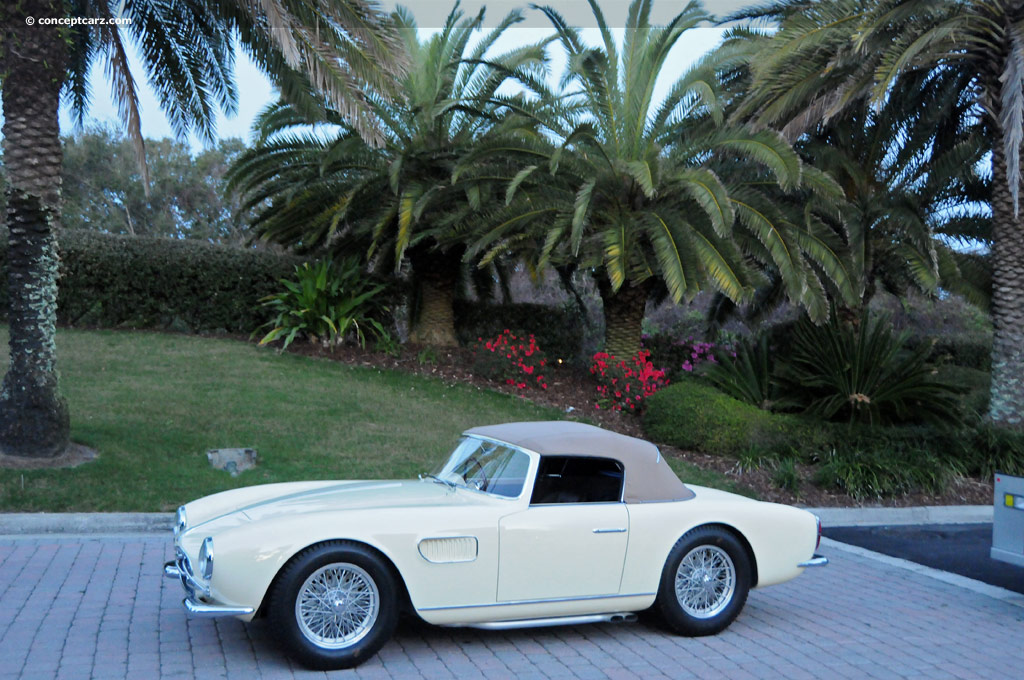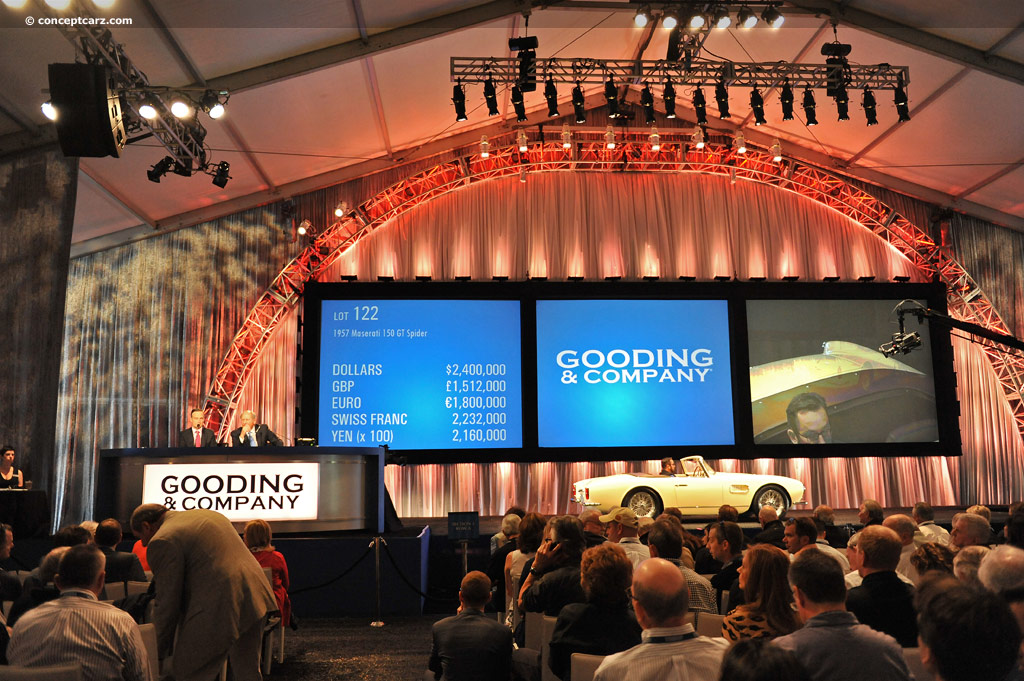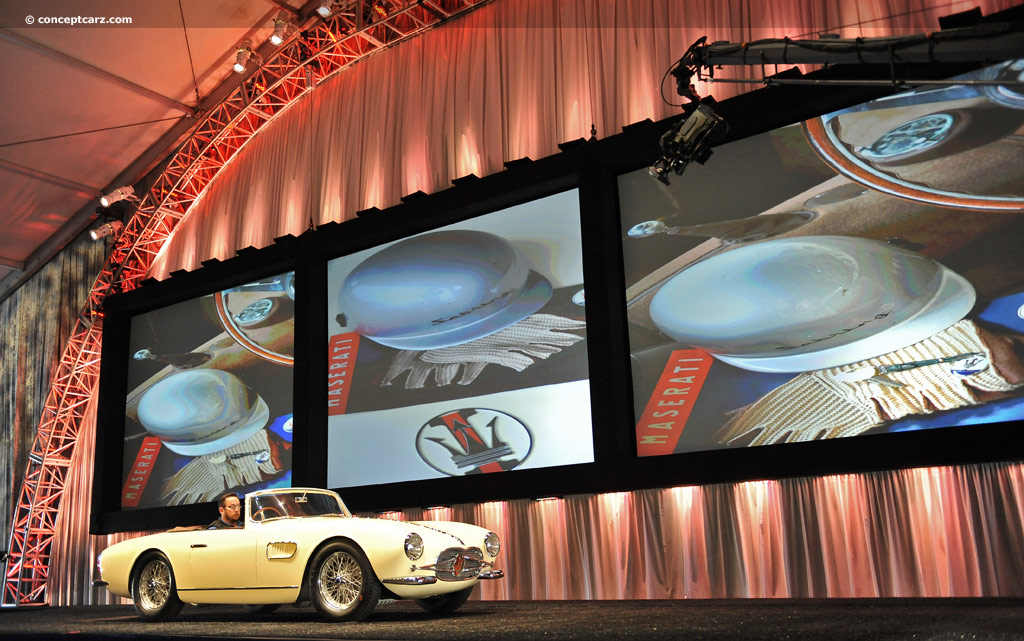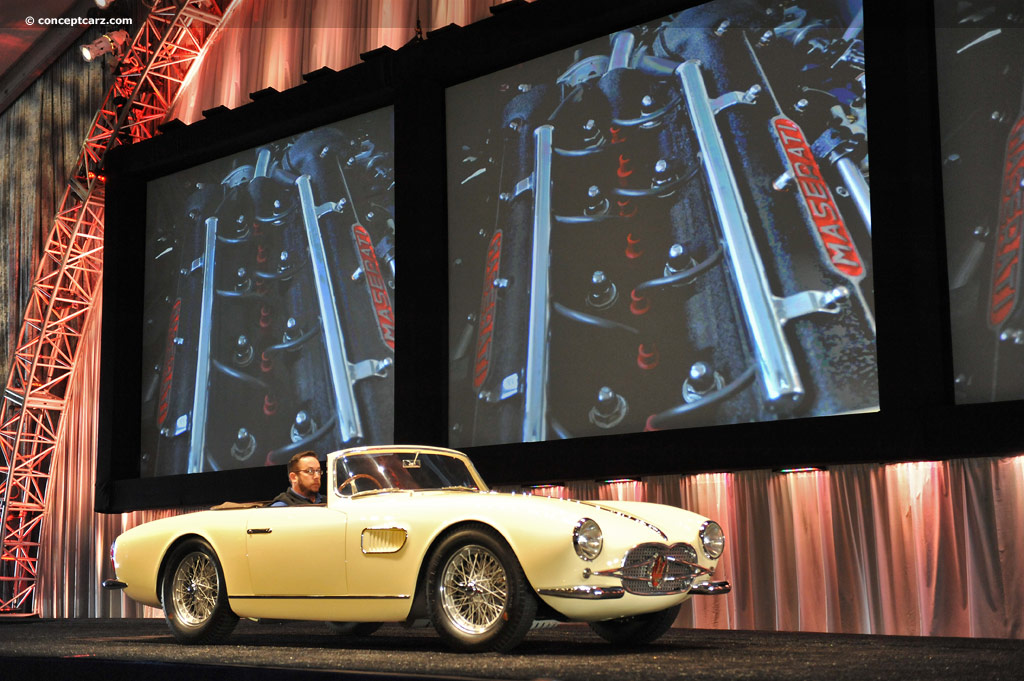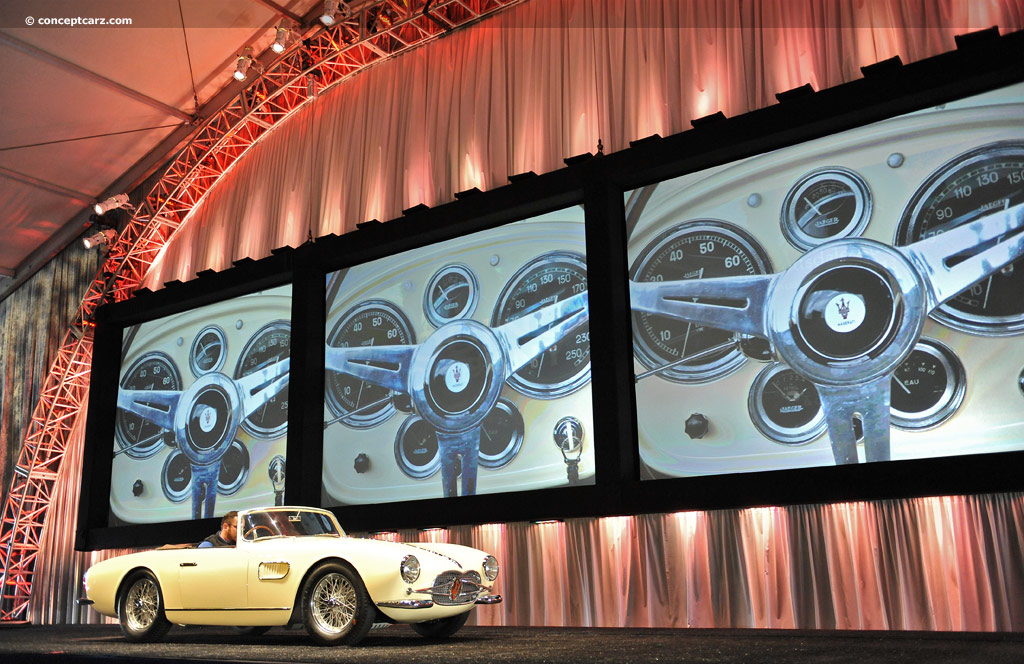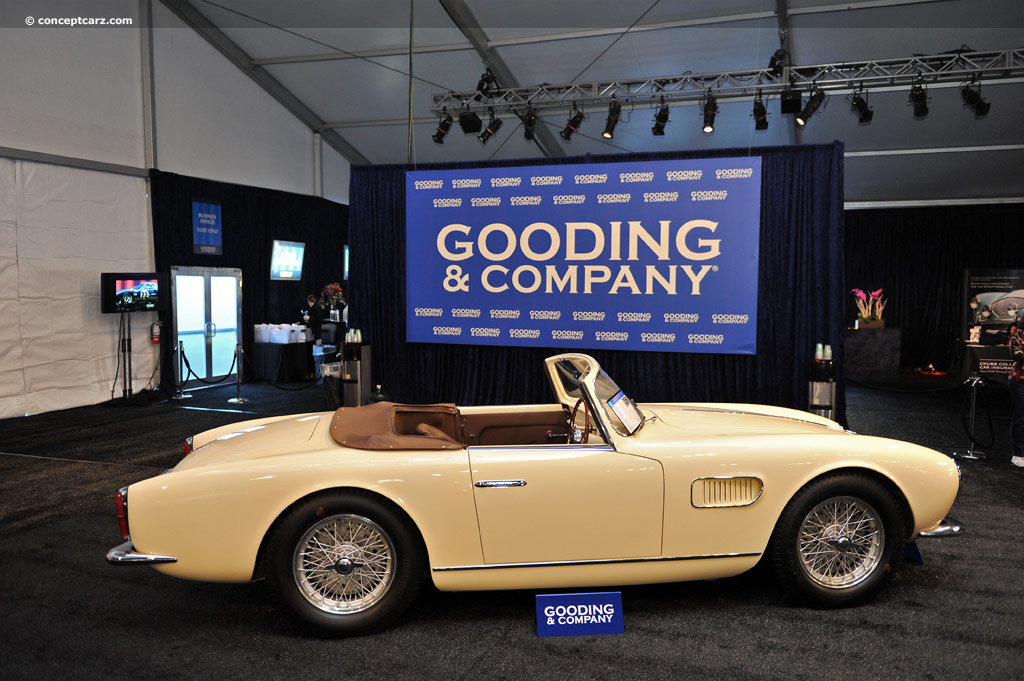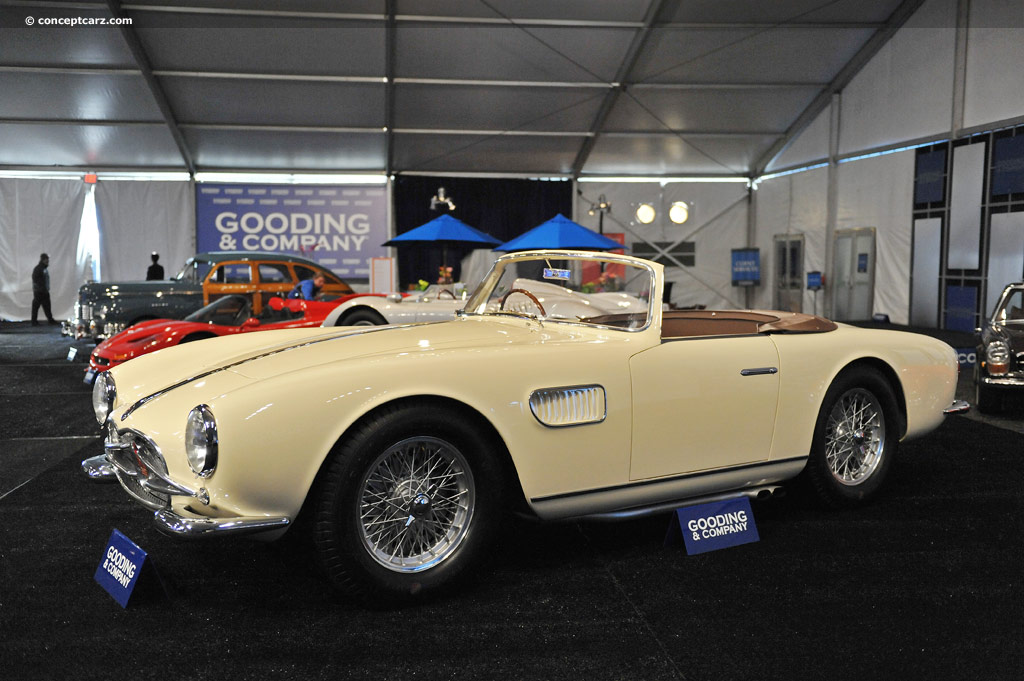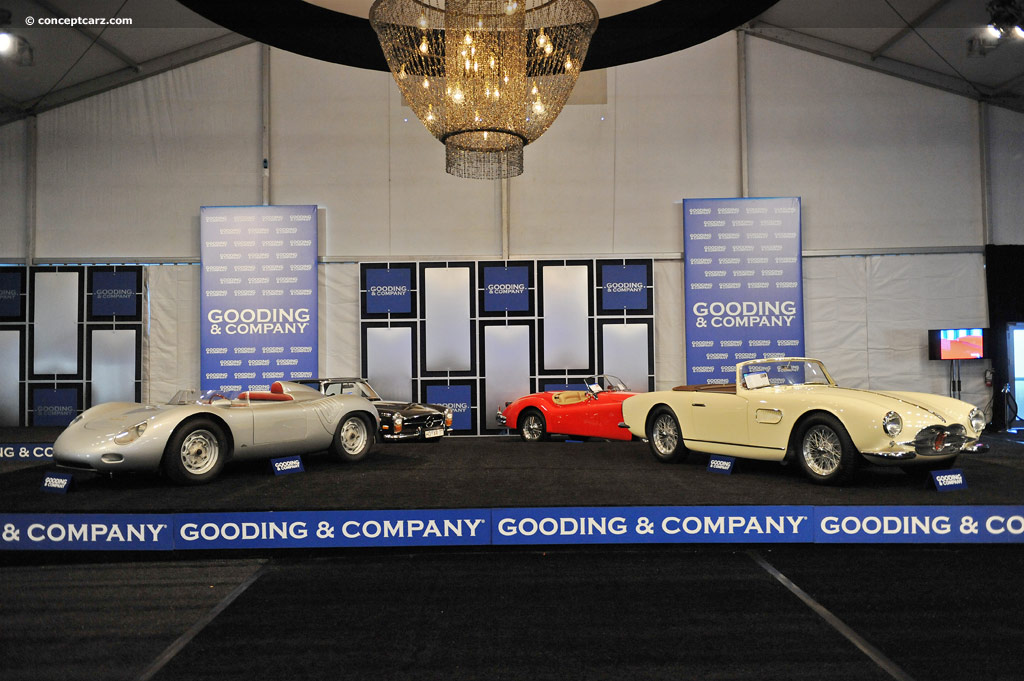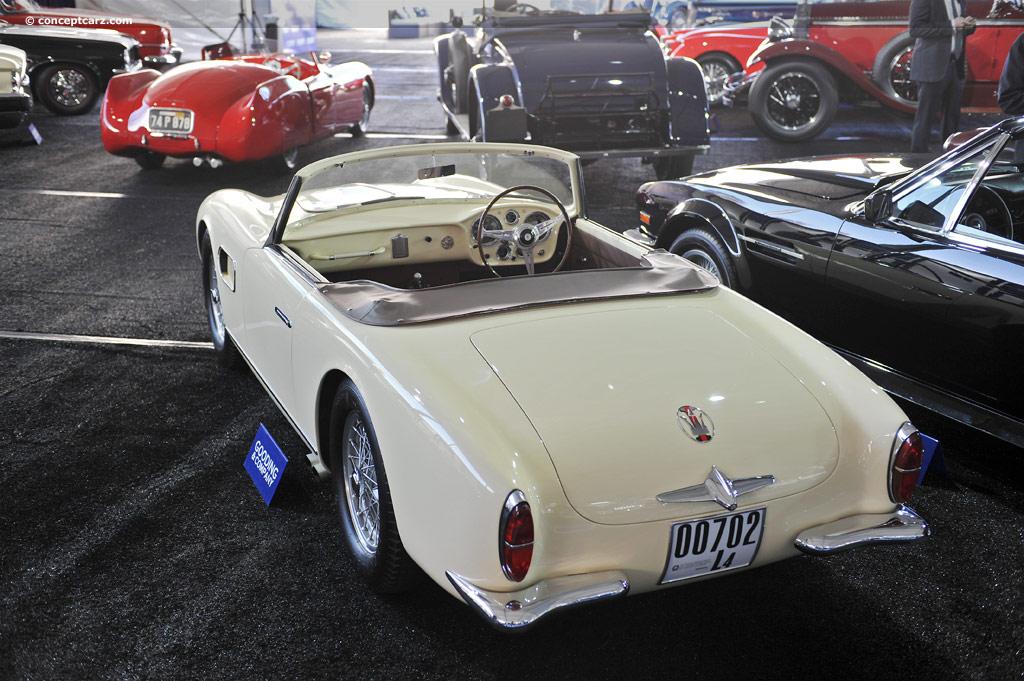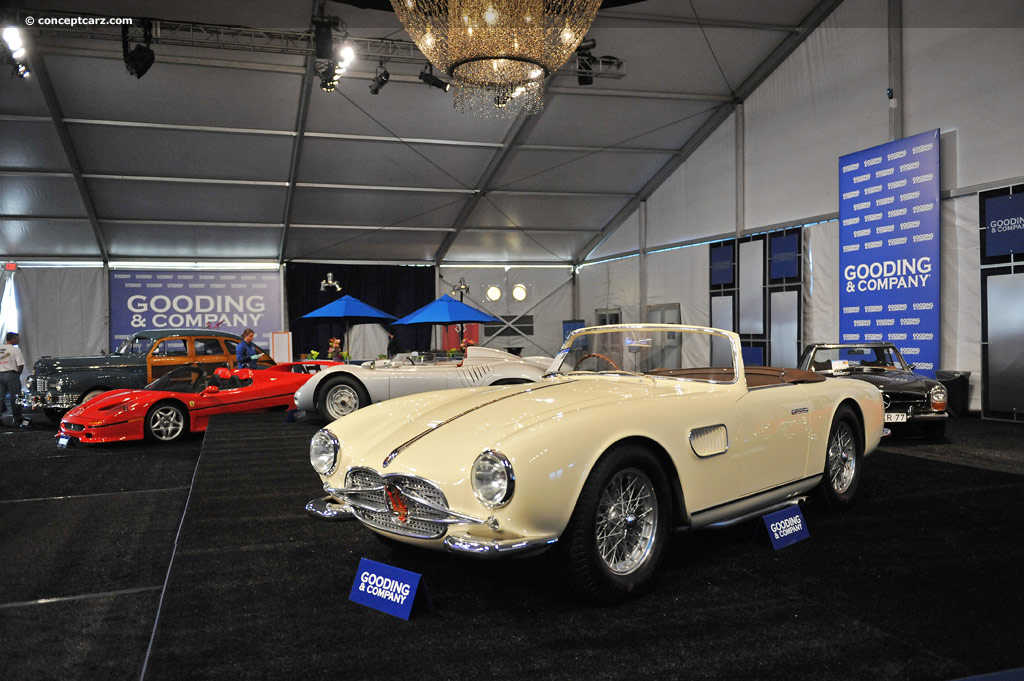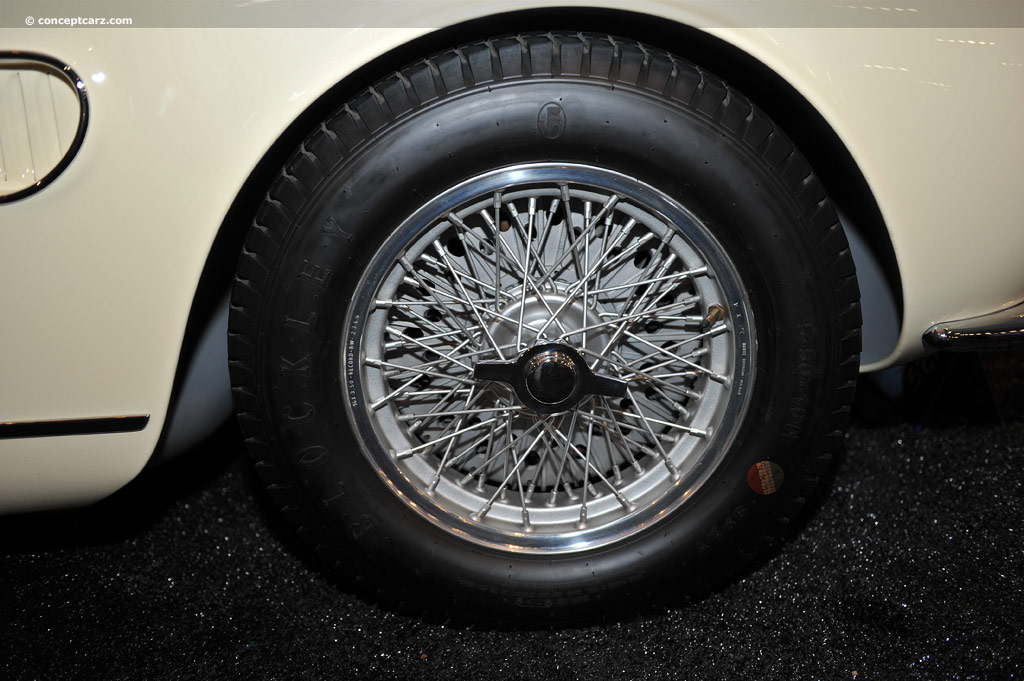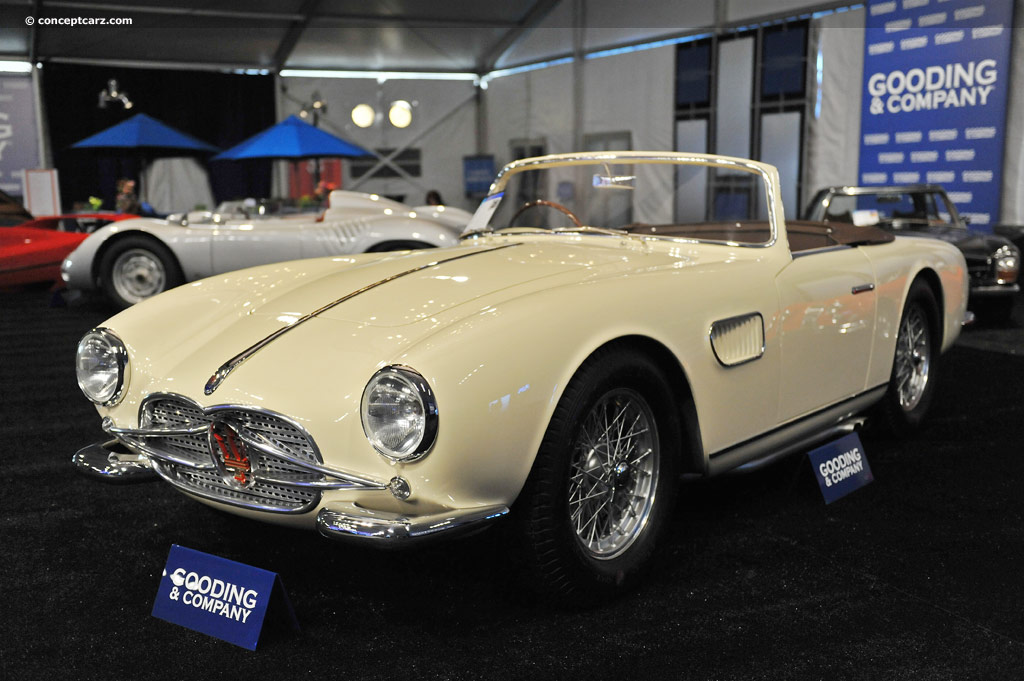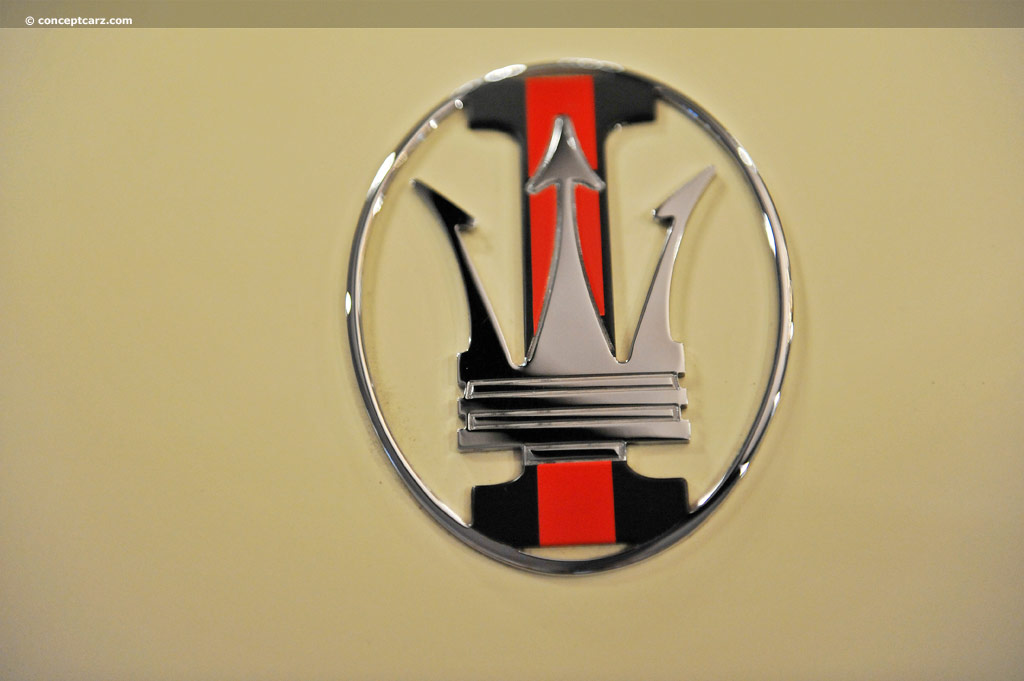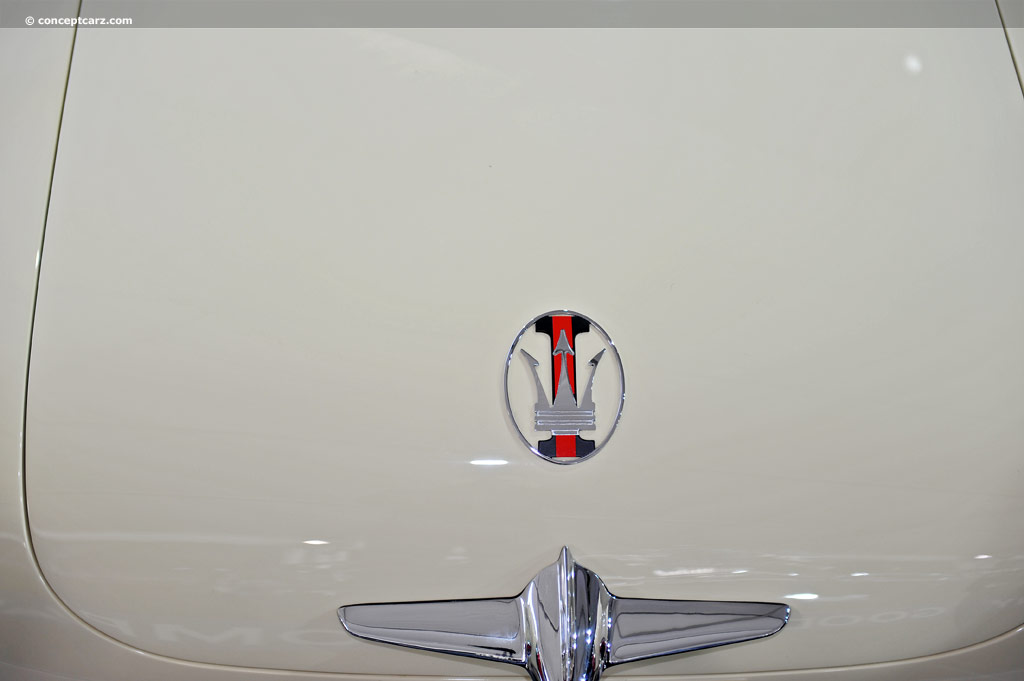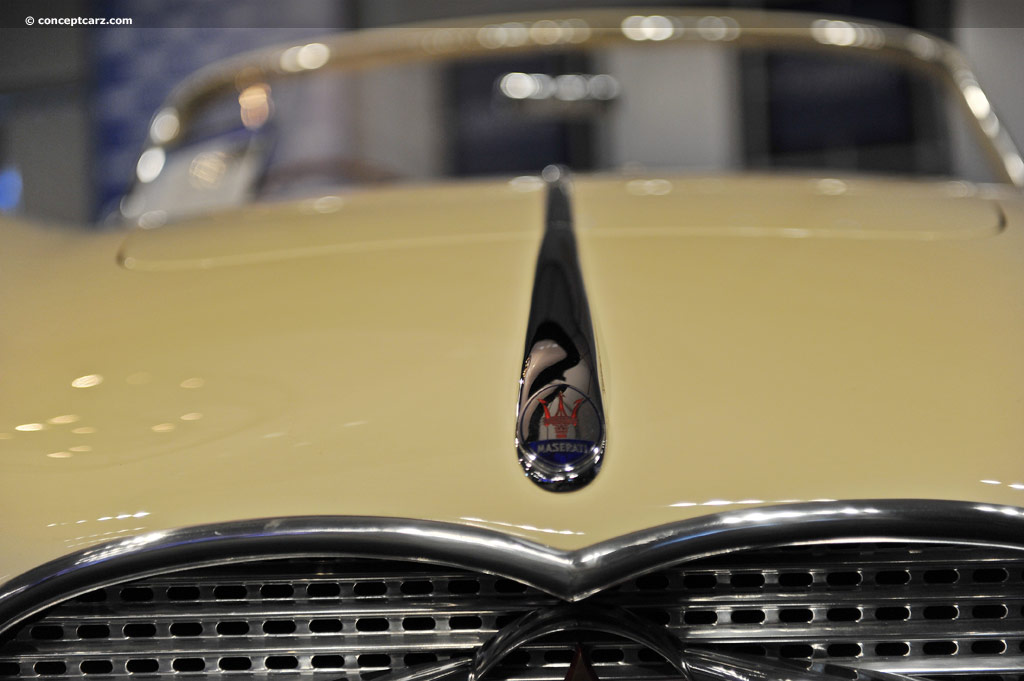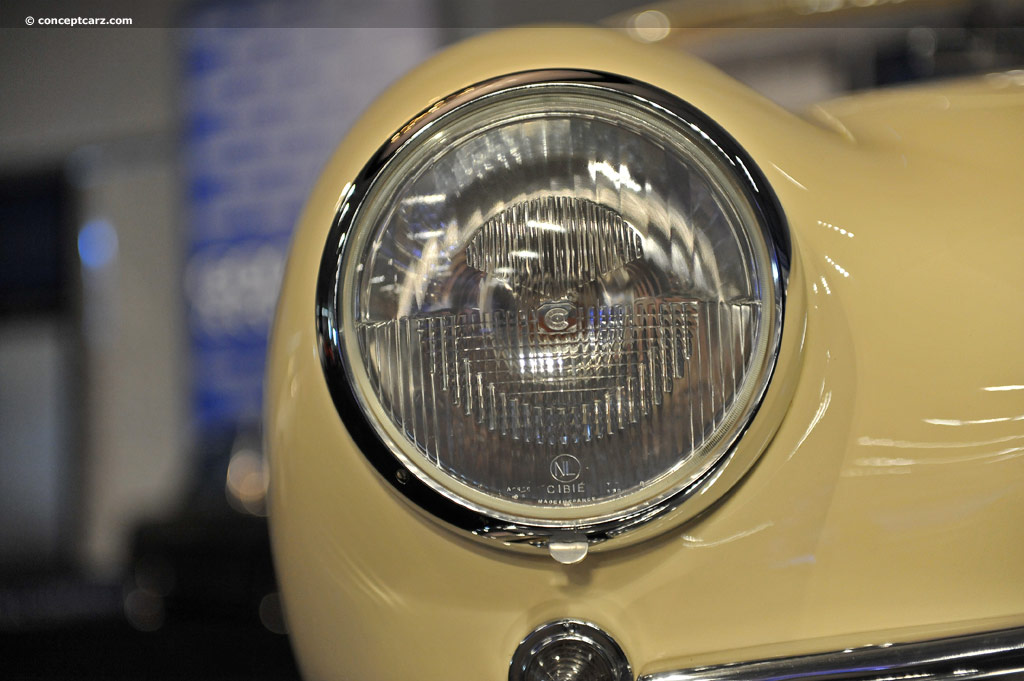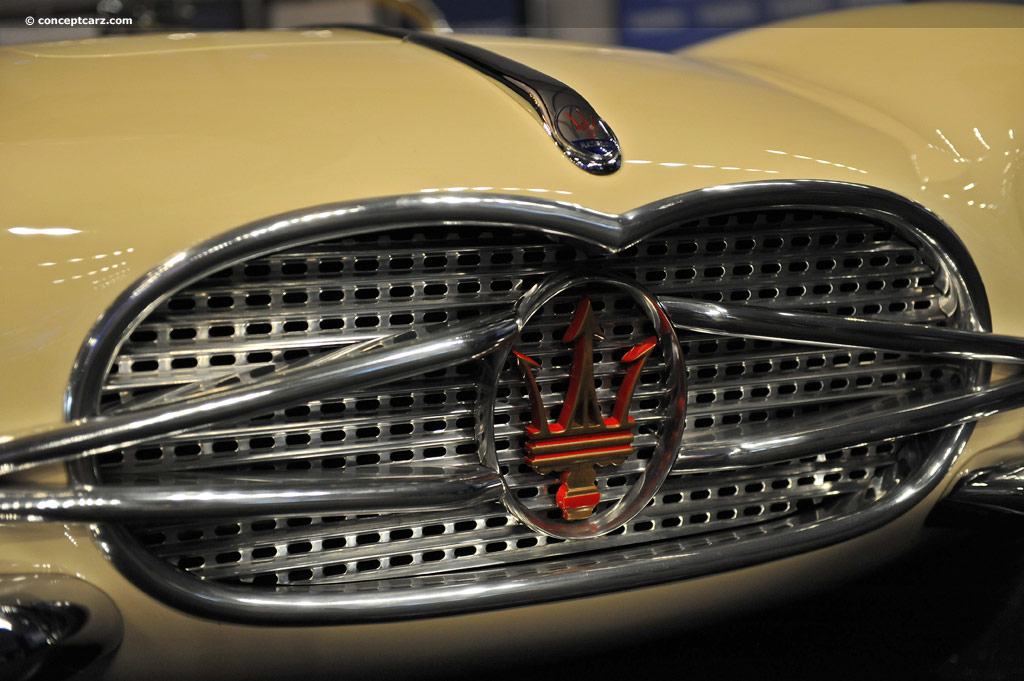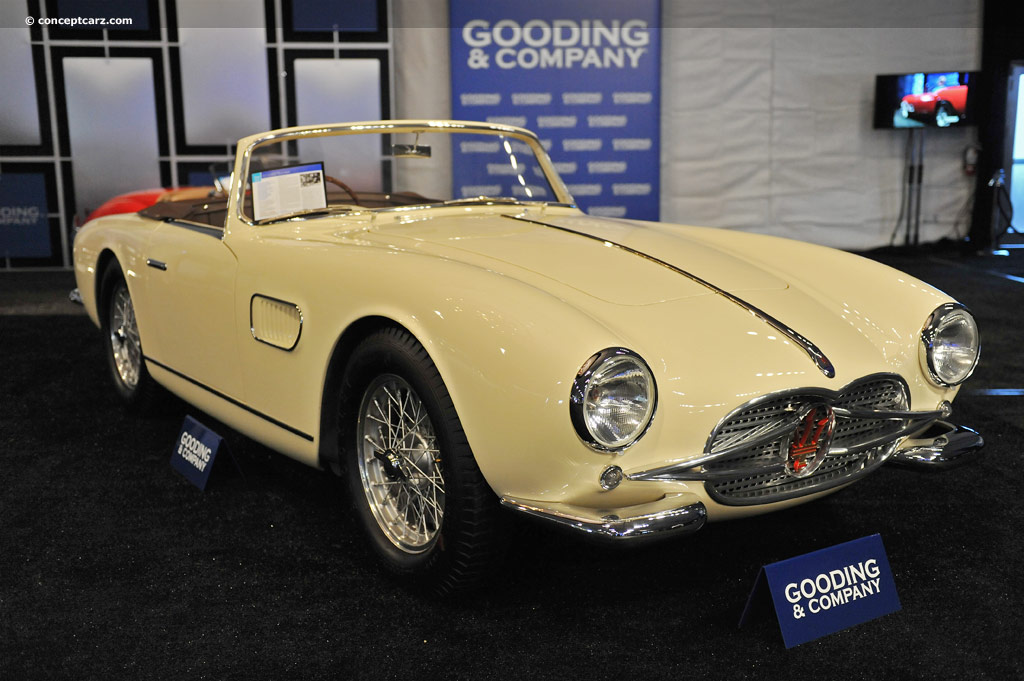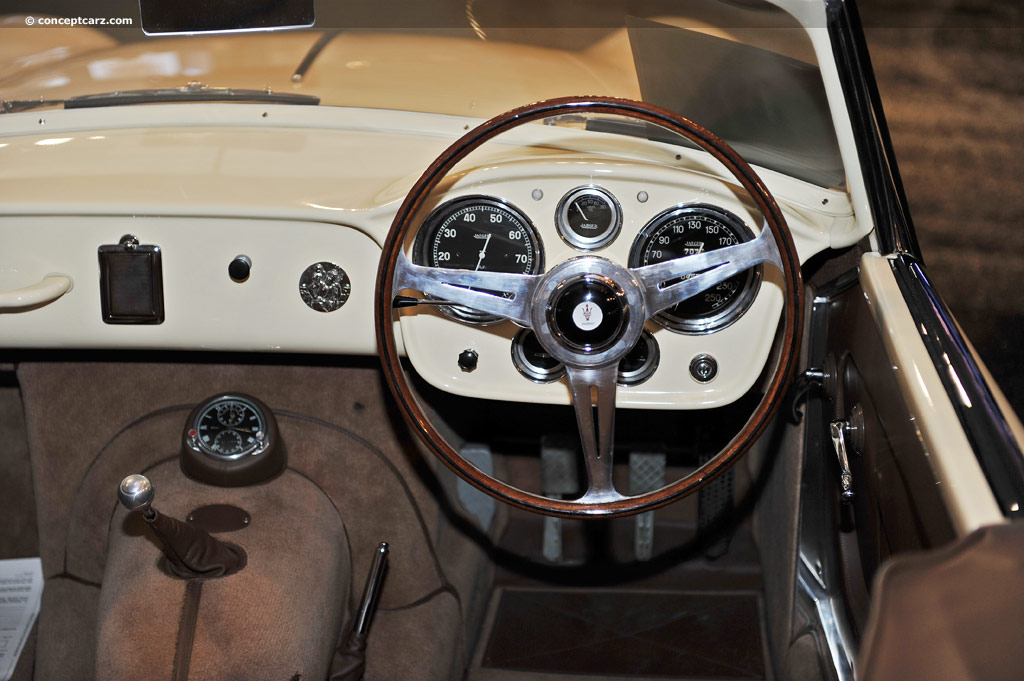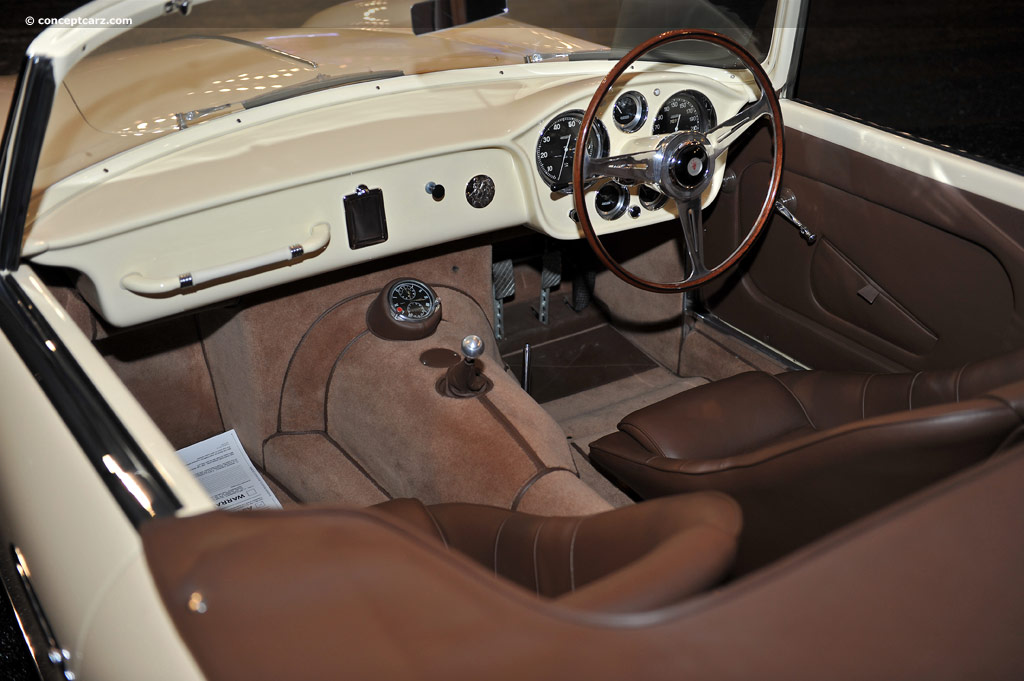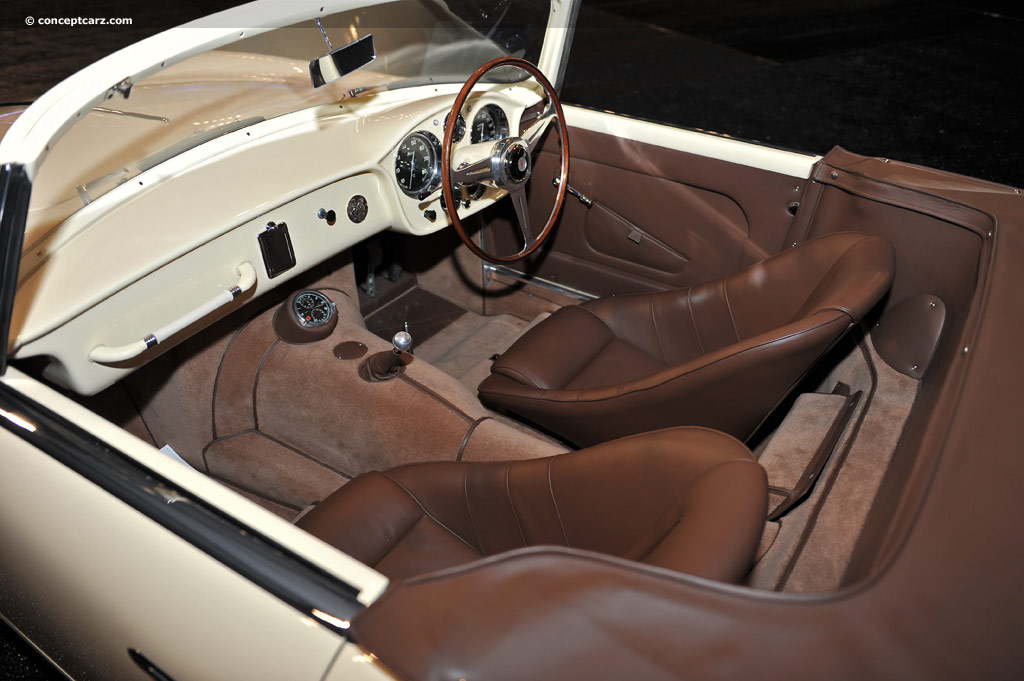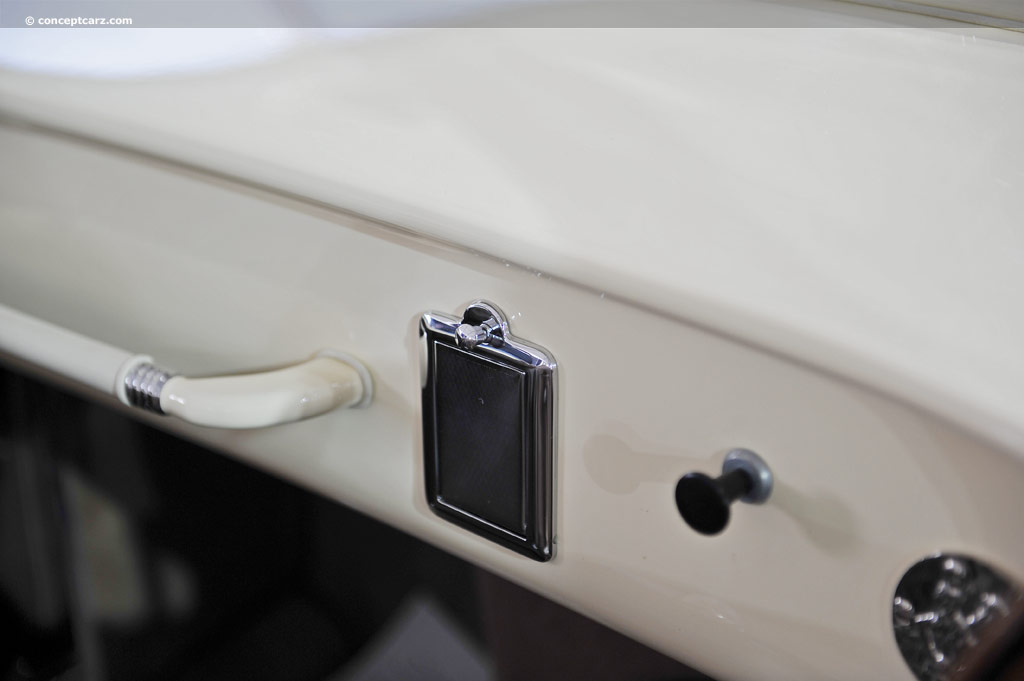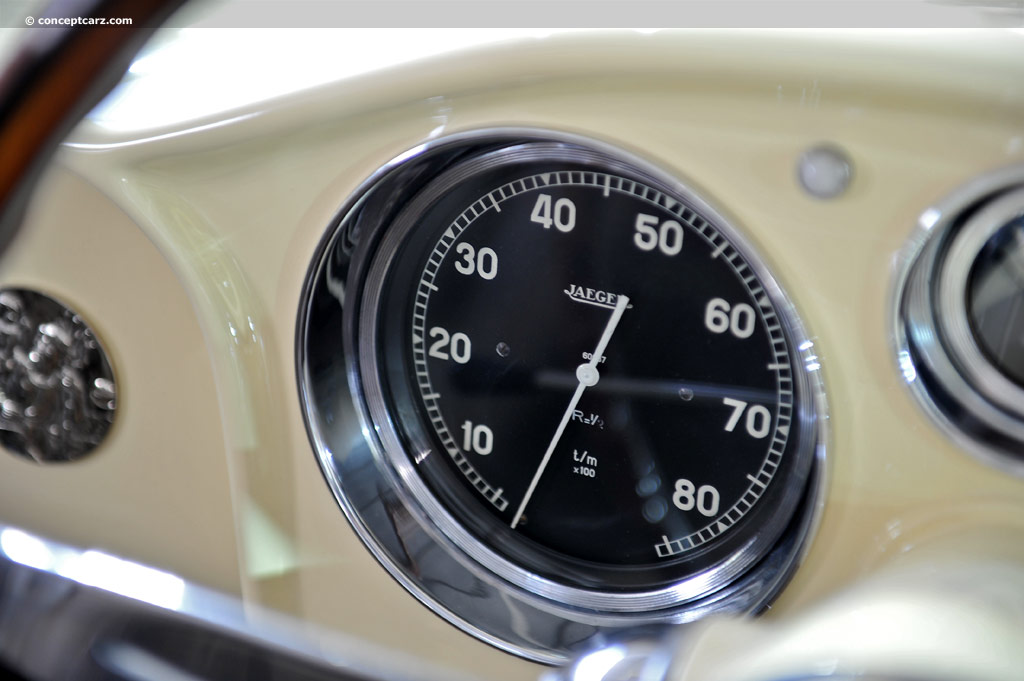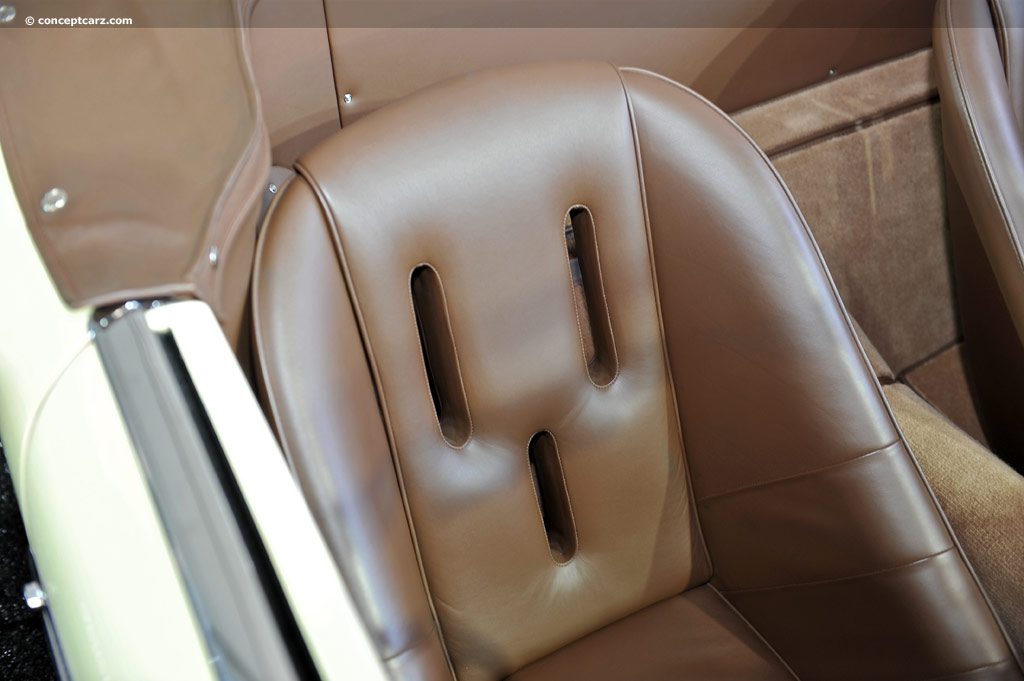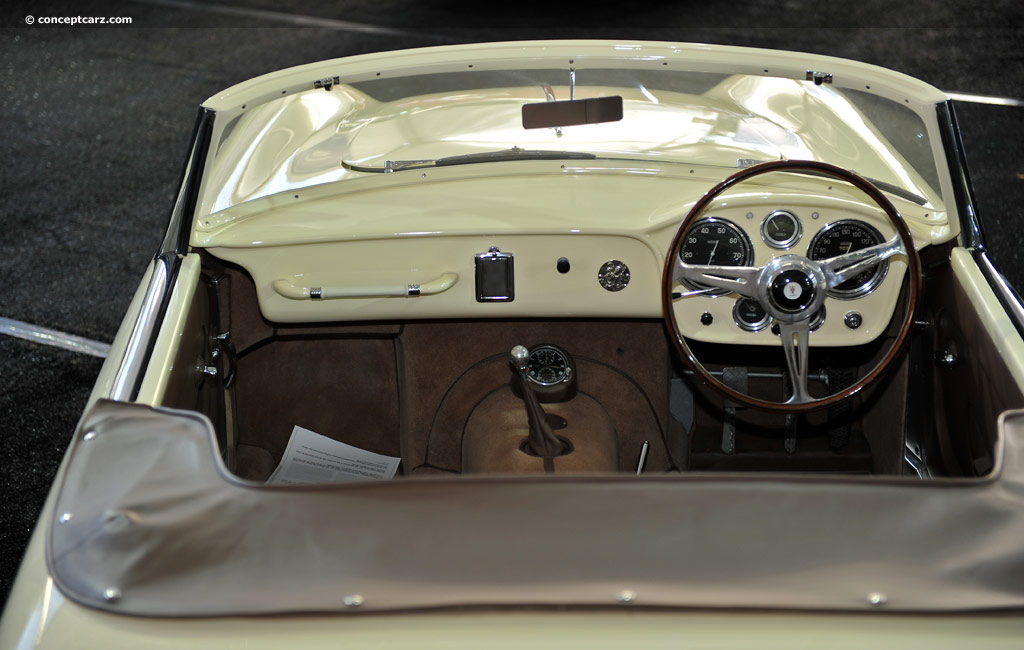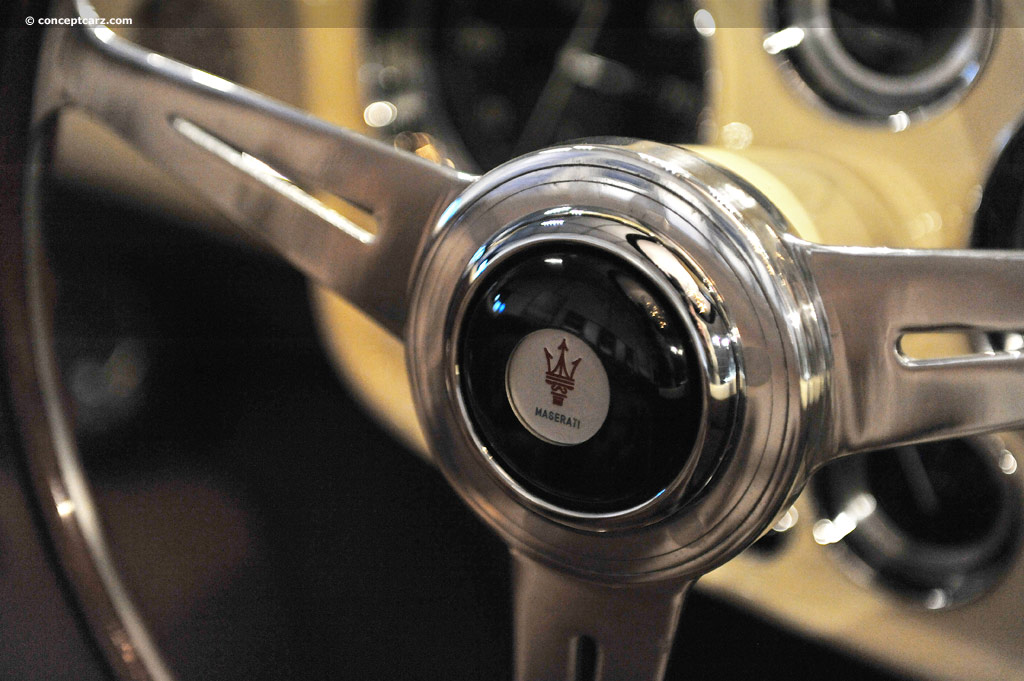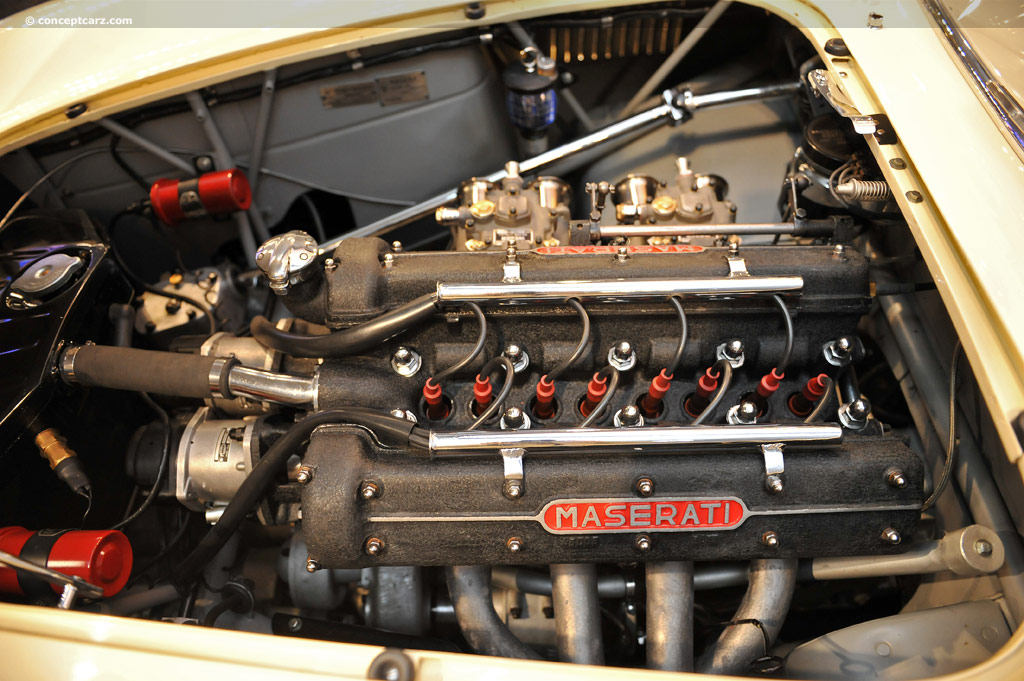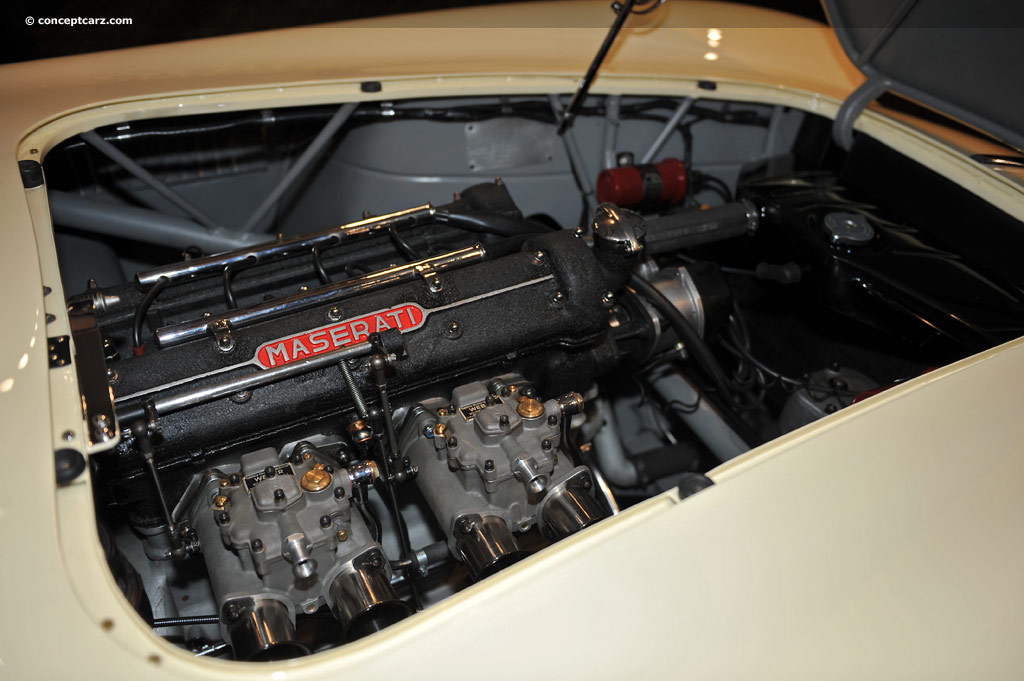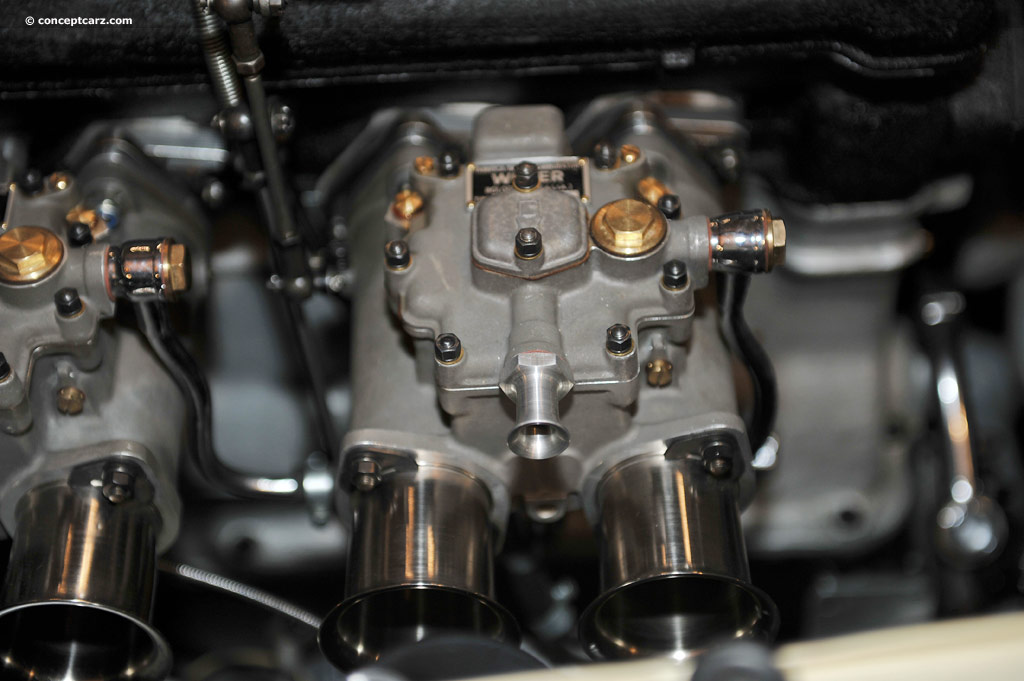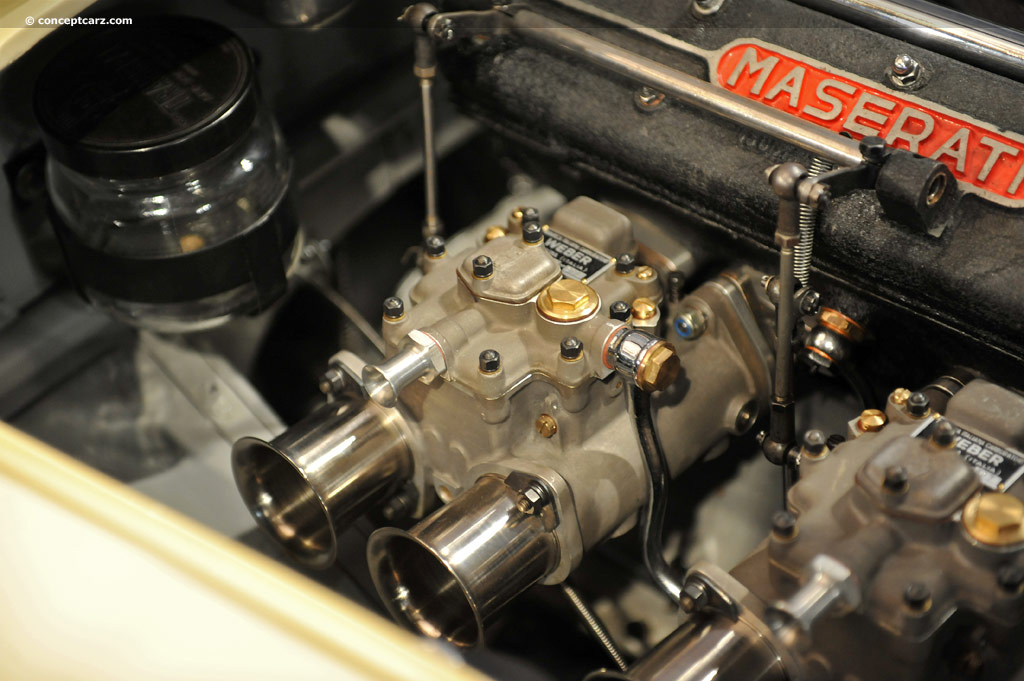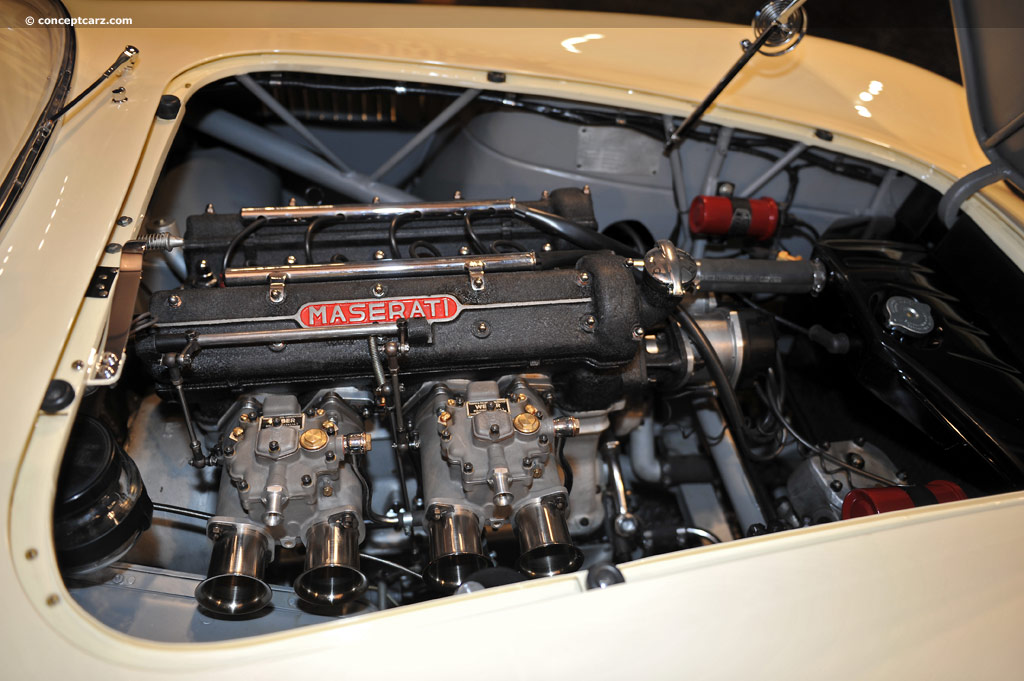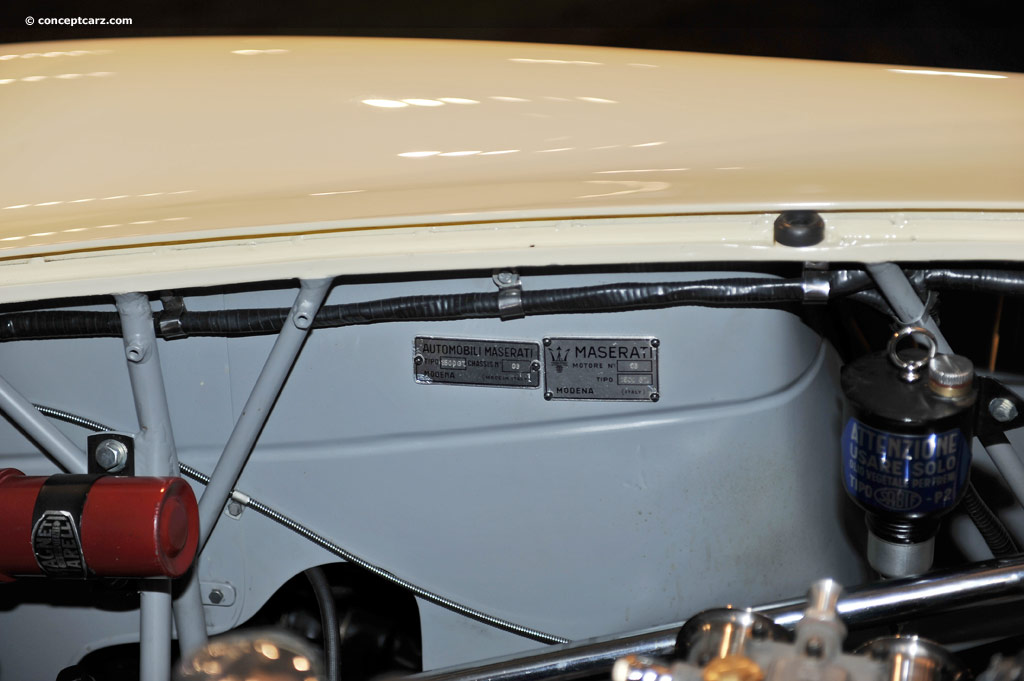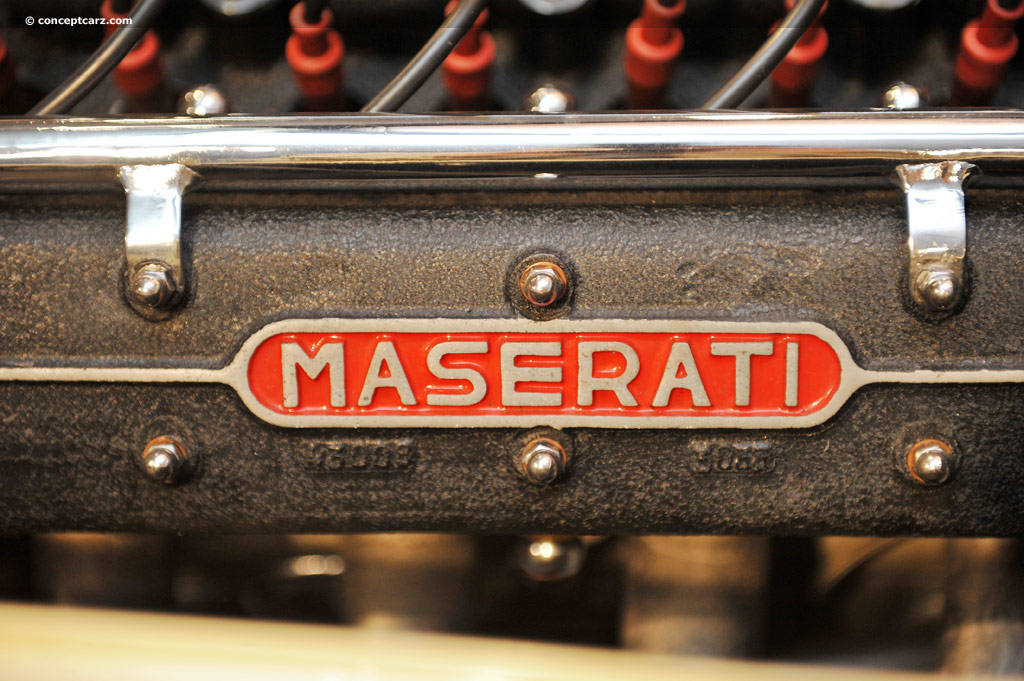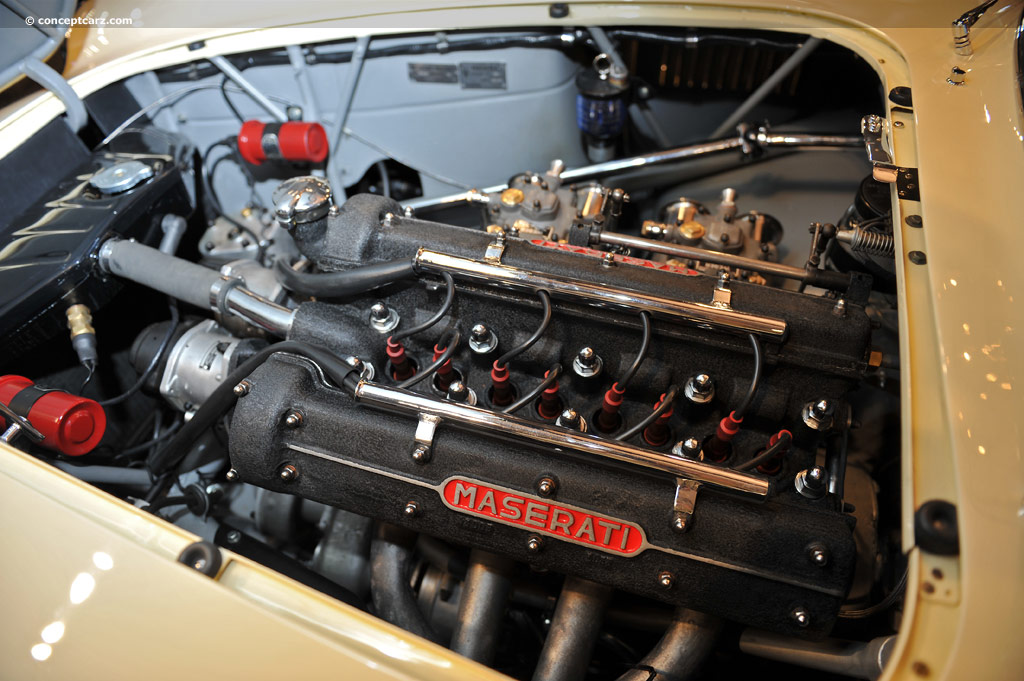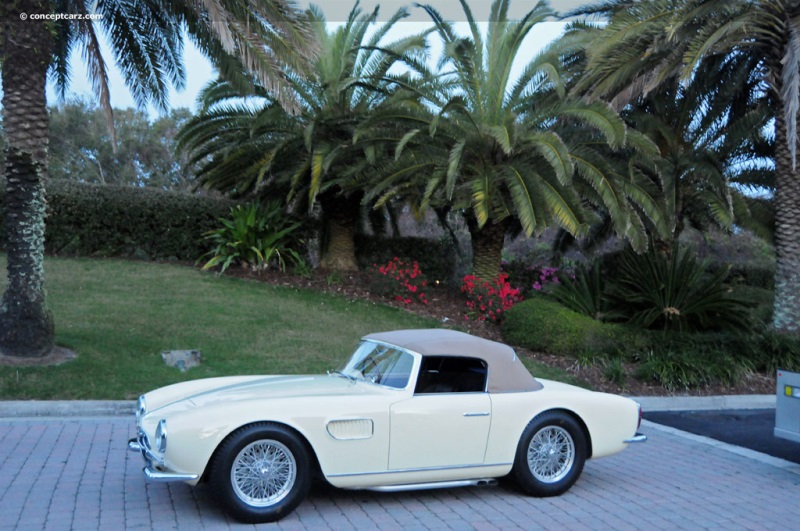Image credit: © conceptcarz.com (Reproduction Or reuse prohibited).
Starting with a foundation similar to that of the 300S sports racer, Maserati revised a successful A6GCS race car chassis to accept a full race 150S engine, an A6G/2000 gearbox casing, and an A6GCS rear-end assembly. After the experimental chassis was completed at the racing department, the design of this 150 GT Spider was entrusted to Carrozzeria Fantuzzi, Maserati's preferred coachbuilder for its sports racing and grand prix cars.
While Pietro Frua has been given credit for the design of this car, it is more likely that the craftsmen at carrozzeria Fantuzzi admire his work and developed their own variation to suit the overly sporting chassis 03.
Completed in late 1957, the 150 GT Spider was an exquisite coachbuilt road car with the performance and pedigree of a thoroughbred racer.
While Pietro Frua has been given credit for the design of this car, it is more likely that the craftsmen at carrozzeria Fantuzzi admire his work and developed their own variation to suit the overly sporting chassis 03.
Completed in late 1957, the 150 GT Spider was an exquisite coachbuilt road car with the performance and pedigree of a thoroughbred racer.
The Maserati 150 GT Spider is a one-of-a-kind vehicle and is unlike any Maserati ever built. The history of this vehicle dates back to May of 1954, when the Maserati factory team presented Luigi Musso with a new A6GCS for the XXI Mille Miglia. The A6GCS carried chassis number 2043, the same identification as the car that he raced throughout the 1953 season.
As was common practice during that era, Maserati often re-numbered their competition chassis, either in the haste of preparation or, more likely, to remain consistent with entry forms prepared well in advance of a race. It is believed that 2043 was entered by Maserati for the 1954 Mille Miglia; the identity was later given to the newly prepared A6GCS.
2043 was given race number 500 and was piloted by Musso and Zocca. It finished the 1,000-mile contest in 3rd overall and 2nd in the two-liter Class. This was the best finish to date at the race for Maserati. 2043 would continue to achieve tremendous success throughout much of the 1954 season, leading to Musso's second consecutive title of Italian Champion in the 2000cc category. His list of accomplishments that year included an overall win at the Grand Prix di Napoli, a 2nd overall and 1st in Class at the Targa Florio, a victory at the Gran prix di Caserta, and a 3rd place finish at the Grand Prix of Imola.
On June 26, Musso and 2043 contested the high-speed race at the Gran Premio Supercortemaggiore at Monza. 2043 was given a detuned 250F engine. Unfortunately, the car failed to finish the race. On July 4th, Musso and 2043 raced at the Gran Prix Pietro Cidonio, where it once again failed to finish due to mechanical trouble. After the race, Musso received a new A6GCS MK. II and 2043 was given to Sergio Mantovani for the Coppa d'Oro delle Dolomiti. The A6GCS, still equipped with the 250F engine, captured the overall win. After that race, it was entered in the Coppa Consuma, where Cesare Perdisa drove 2043 to a 2nd overall and 1st in Class.
Valenzano was tasked with the driving duties for the remainder of the 1954 season. Valenzano drove the A6GCS to a 5th overall at Aosta-San Bernardino and an outright victory at Borzonasca-La Squazza. After this race, the car seemed to disappear from sight. By this point in history, the 250F had become a dominant contender in Grand Prix Racing. Hoping to stay competitive in four-cylinder sports car two-liter racing, Maserati envisioned a sports car that combined the balance of the A6GCS with the power of the 250 Grand Prix machine. Financial difficulties were an issue, however. So instead of introducing a completely new model line, the racing department looked to develop the well-proven A6GCS into an outright winner.
The remainder of 1954 was spent by Maserati engineers modifying the original A6GCS chassis until they arrived at the basic 300S platform. When the 300S made its debut, it shared little with the A6GCS sibling; only the front suspension from both models were the same.
During the early stages of development, Maserati modified an A6GCS to accept a detuned 250F engine, 250F drum brakes, larger wheels, longer wheelbase, right-hand drive steering, and revised bodywork distinguished by an extended nose, long doors, and covered headlamps. This experimental car was given internal designation 001. It was used in the 1954 Mille Miglia where Mantovani drove it under race number 537. By this point in history, it had little development, testing, and tuning under its belt. It retired just after Ferrara and was eventually returned to its original A6GCS configuration.
During the second stage of development, the racing department created a new prototype chassis. It was, in essence, was a strengthened version of the 150S and 200S space frame. This chassis was internally designated 002. It too utilized many 250F components. It was entered in the 1954 Gran Premio Supercortemaggiore at Monza. The car maintained 2nd place until retiring in the final laps. Though it had a very promising debut, this car was not entered in any more races. Instead, it was used to test new six-cylinder engines.
During the third and final stage of development, the Maserati team arrived at the official 300S prototype. As would be expected, this new prototype was given the internal designation of 003. It was based on chassis 2043, the A6GCS that had scored many important victories through the 1954 season.
After its retirement in August of 1954, 2043 was again fitted with a 250F engine and further modified with a 250F clutch, driveshaft, four-speed transaxle, and DeDion rear end.
003 showed tremendous promise, but the revised A6GCS chassis ultimately proved inadequate. Extensive chassis revisions were undertaken until Maserati arrived at the definitive 300S design. It was given an all-new body and a right-hand drive steering configuration. After several attempts, Maserati had successfully completed the transformation from an A6GCS to the first true 300S prototype.
003 was put through its paces and on December 5th of 1954, Jean Behra performed the final tests on 003. Soon after, Maserati began production of the 300S. The racing department had no further use for 003; it was stripped of its mechanical components and coachwork, converted from right- to left-hand drive, and the 300S prototype body was eventually mounted on a left-hand-drive A6GCS, chassis 2099. All that remained of chassis 003 was a bare frame, nearly identical to that of the production 300S. It remained in the racing department for some 18 months before Maserati discovered another use for it.
By 1956, Maserati was in need of a new road-going sports car to serve as a replacement for its limited production A6G/2000. Not sure what the future might hold, the company built two vehicles in parallel - a four-cylinder sports car and a six-cylinder gran turismo.
Chief Engineer Giulio Alfieri worked on the development of the gran turismo. The sports car project was entrusted to Maserati's racing department. Trying to keep costs to a minimum and to make use of existing resources, the engineers used chassis 003, which had served the company as a successful A6GCS sports racing car and the basis for the 300S prototype.
The chassis was taken out of storage and work began on a four-cylinder sports car prototype called the 150 GT Spider. The 150 GT Spider was constructed in late 1957. The chassis was revised to accept a full-race 150S engine, an A6G/2000 gearbox casing, a 200S prop shaft, and an A6GCS rear-end assembly. The front suspension and hubs remained virtually unchanged from their original A6GCS specifications. The front brakes were sourced from a 250F, and the steering mechanism combined 250F and A6G/2000 components. Other notable features included a 200S radiator, a A6GCS rear brake system, a 150S oil pump, and a new wet-sump lubrication system better suited for road use.
The factory build sheet recorded the chassis number as 003, however, the stampings on the car itself carried just two digits. The 150 GT Spider has always been known simply as 03.
After the chassis work was completed, 03 was sent to Carrozzeria Fantuzzi to be clothed in a one-of-a-kind Spider coachwork. It was constructed in lightweight aluminum. The front grille appears to have been influenced by Zagato while the fender vents seem to have been sourced from an Allemano body.
The finished work was completed in Avorio (ivory) with Marrone (brown) upholstery. It retained the right-hand drive configuration of the 300S prototype and was specified with a painted dashboard, anti-dazzle interior mirror, and English instruments, a full convertible top and roll-up windows.
Though the completed car had performance, pedigree, and elegance, it was deemed too complex and expensive to build in any significant numbers. Instead, Maserati management decided to move forward with the 3500 GT. The decision was made in the company's best interest. Throughout the late 1950s and early 1960s, sales of the 3500 GT generated a consistent income.
Not sure of the future of the 150 GT Spider, it remained sequestered in the factory's racing department where it could be safely stored out of the public eye. On rare occasions, Maserati made the 150 GT Spider available to important clients and influential journalists.
After the car's final public demonstration, Officine Alfieri Maserati issued the Certificate of Origin for chassis 03. dated October 31, 1959. Around this point in history, a deal was reached for the 150 GT to be sold to the newly appointed British Maserati agent Colin Murray of Fleetwood, Lancashire. By the close of 1960, Murray had sold the 150 GT to Mr. Harrison, and was subsequently registered in Great Britain as '3 CLP.' It next appeared in November of 1966, where it was offered for sale in Motor Sport with a £1,400 asking price. It was purchased by Mr. Blythe and believed that the 150 GT remained in private UK ownership and received some minor restoration work at McKenzie Guppy Ltd. in Dorset in the early 1980s. By 1989, chassis 03 was owned by Graham Walker, a resident of Jersey, Channel Islands. In 1993, Mr. Walker traded the Maserati to a German collector in a deal that involved an Aston Martin DB4 GT.
During the 1990s and early 200s, the Maserati remained in the care of its private collector where it was largely untouched. Since then, it has remained relatively unseen. The current owner acquired the car in 2006. The new caretaker returned the car to its original glory, with a complete, no-expense-spared restoration over a three-year period.
Currently, the car is powered by a 1994cc dual overhead cam four-cylinder engine fitted with Twin Weber 40 DCO3 carburetors. The engine produces an estimated 190 horsepower and is mated to a four-speed manual gearbox with synchromesh. There are four-wheel hydraulic drum brakes and an independent front suspension.By Daniel Vaughan | Feb 2013
As was common practice during that era, Maserati often re-numbered their competition chassis, either in the haste of preparation or, more likely, to remain consistent with entry forms prepared well in advance of a race. It is believed that 2043 was entered by Maserati for the 1954 Mille Miglia; the identity was later given to the newly prepared A6GCS.
2043 was given race number 500 and was piloted by Musso and Zocca. It finished the 1,000-mile contest in 3rd overall and 2nd in the two-liter Class. This was the best finish to date at the race for Maserati. 2043 would continue to achieve tremendous success throughout much of the 1954 season, leading to Musso's second consecutive title of Italian Champion in the 2000cc category. His list of accomplishments that year included an overall win at the Grand Prix di Napoli, a 2nd overall and 1st in Class at the Targa Florio, a victory at the Gran prix di Caserta, and a 3rd place finish at the Grand Prix of Imola.
On June 26, Musso and 2043 contested the high-speed race at the Gran Premio Supercortemaggiore at Monza. 2043 was given a detuned 250F engine. Unfortunately, the car failed to finish the race. On July 4th, Musso and 2043 raced at the Gran Prix Pietro Cidonio, where it once again failed to finish due to mechanical trouble. After the race, Musso received a new A6GCS MK. II and 2043 was given to Sergio Mantovani for the Coppa d'Oro delle Dolomiti. The A6GCS, still equipped with the 250F engine, captured the overall win. After that race, it was entered in the Coppa Consuma, where Cesare Perdisa drove 2043 to a 2nd overall and 1st in Class.
Valenzano was tasked with the driving duties for the remainder of the 1954 season. Valenzano drove the A6GCS to a 5th overall at Aosta-San Bernardino and an outright victory at Borzonasca-La Squazza. After this race, the car seemed to disappear from sight. By this point in history, the 250F had become a dominant contender in Grand Prix Racing. Hoping to stay competitive in four-cylinder sports car two-liter racing, Maserati envisioned a sports car that combined the balance of the A6GCS with the power of the 250 Grand Prix machine. Financial difficulties were an issue, however. So instead of introducing a completely new model line, the racing department looked to develop the well-proven A6GCS into an outright winner.
The remainder of 1954 was spent by Maserati engineers modifying the original A6GCS chassis until they arrived at the basic 300S platform. When the 300S made its debut, it shared little with the A6GCS sibling; only the front suspension from both models were the same.
During the early stages of development, Maserati modified an A6GCS to accept a detuned 250F engine, 250F drum brakes, larger wheels, longer wheelbase, right-hand drive steering, and revised bodywork distinguished by an extended nose, long doors, and covered headlamps. This experimental car was given internal designation 001. It was used in the 1954 Mille Miglia where Mantovani drove it under race number 537. By this point in history, it had little development, testing, and tuning under its belt. It retired just after Ferrara and was eventually returned to its original A6GCS configuration.
During the second stage of development, the racing department created a new prototype chassis. It was, in essence, was a strengthened version of the 150S and 200S space frame. This chassis was internally designated 002. It too utilized many 250F components. It was entered in the 1954 Gran Premio Supercortemaggiore at Monza. The car maintained 2nd place until retiring in the final laps. Though it had a very promising debut, this car was not entered in any more races. Instead, it was used to test new six-cylinder engines.
During the third and final stage of development, the Maserati team arrived at the official 300S prototype. As would be expected, this new prototype was given the internal designation of 003. It was based on chassis 2043, the A6GCS that had scored many important victories through the 1954 season.
After its retirement in August of 1954, 2043 was again fitted with a 250F engine and further modified with a 250F clutch, driveshaft, four-speed transaxle, and DeDion rear end.
003 showed tremendous promise, but the revised A6GCS chassis ultimately proved inadequate. Extensive chassis revisions were undertaken until Maserati arrived at the definitive 300S design. It was given an all-new body and a right-hand drive steering configuration. After several attempts, Maserati had successfully completed the transformation from an A6GCS to the first true 300S prototype.
003 was put through its paces and on December 5th of 1954, Jean Behra performed the final tests on 003. Soon after, Maserati began production of the 300S. The racing department had no further use for 003; it was stripped of its mechanical components and coachwork, converted from right- to left-hand drive, and the 300S prototype body was eventually mounted on a left-hand-drive A6GCS, chassis 2099. All that remained of chassis 003 was a bare frame, nearly identical to that of the production 300S. It remained in the racing department for some 18 months before Maserati discovered another use for it.
By 1956, Maserati was in need of a new road-going sports car to serve as a replacement for its limited production A6G/2000. Not sure what the future might hold, the company built two vehicles in parallel - a four-cylinder sports car and a six-cylinder gran turismo.
Chief Engineer Giulio Alfieri worked on the development of the gran turismo. The sports car project was entrusted to Maserati's racing department. Trying to keep costs to a minimum and to make use of existing resources, the engineers used chassis 003, which had served the company as a successful A6GCS sports racing car and the basis for the 300S prototype.
The chassis was taken out of storage and work began on a four-cylinder sports car prototype called the 150 GT Spider. The 150 GT Spider was constructed in late 1957. The chassis was revised to accept a full-race 150S engine, an A6G/2000 gearbox casing, a 200S prop shaft, and an A6GCS rear-end assembly. The front suspension and hubs remained virtually unchanged from their original A6GCS specifications. The front brakes were sourced from a 250F, and the steering mechanism combined 250F and A6G/2000 components. Other notable features included a 200S radiator, a A6GCS rear brake system, a 150S oil pump, and a new wet-sump lubrication system better suited for road use.
The factory build sheet recorded the chassis number as 003, however, the stampings on the car itself carried just two digits. The 150 GT Spider has always been known simply as 03.
After the chassis work was completed, 03 was sent to Carrozzeria Fantuzzi to be clothed in a one-of-a-kind Spider coachwork. It was constructed in lightweight aluminum. The front grille appears to have been influenced by Zagato while the fender vents seem to have been sourced from an Allemano body.
The finished work was completed in Avorio (ivory) with Marrone (brown) upholstery. It retained the right-hand drive configuration of the 300S prototype and was specified with a painted dashboard, anti-dazzle interior mirror, and English instruments, a full convertible top and roll-up windows.
Though the completed car had performance, pedigree, and elegance, it was deemed too complex and expensive to build in any significant numbers. Instead, Maserati management decided to move forward with the 3500 GT. The decision was made in the company's best interest. Throughout the late 1950s and early 1960s, sales of the 3500 GT generated a consistent income.
Not sure of the future of the 150 GT Spider, it remained sequestered in the factory's racing department where it could be safely stored out of the public eye. On rare occasions, Maserati made the 150 GT Spider available to important clients and influential journalists.
After the car's final public demonstration, Officine Alfieri Maserati issued the Certificate of Origin for chassis 03. dated October 31, 1959. Around this point in history, a deal was reached for the 150 GT to be sold to the newly appointed British Maserati agent Colin Murray of Fleetwood, Lancashire. By the close of 1960, Murray had sold the 150 GT to Mr. Harrison, and was subsequently registered in Great Britain as '3 CLP.' It next appeared in November of 1966, where it was offered for sale in Motor Sport with a £1,400 asking price. It was purchased by Mr. Blythe and believed that the 150 GT remained in private UK ownership and received some minor restoration work at McKenzie Guppy Ltd. in Dorset in the early 1980s. By 1989, chassis 03 was owned by Graham Walker, a resident of Jersey, Channel Islands. In 1993, Mr. Walker traded the Maserati to a German collector in a deal that involved an Aston Martin DB4 GT.
During the 1990s and early 200s, the Maserati remained in the care of its private collector where it was largely untouched. Since then, it has remained relatively unseen. The current owner acquired the car in 2006. The new caretaker returned the car to its original glory, with a complete, no-expense-spared restoration over a three-year period.
Currently, the car is powered by a 1994cc dual overhead cam four-cylinder engine fitted with Twin Weber 40 DCO3 carburetors. The engine produces an estimated 190 horsepower and is mated to a four-speed manual gearbox with synchromesh. There are four-wheel hydraulic drum brakes and an independent front suspension.By Daniel Vaughan | Feb 2013
2013 Gooding and Company - The Scottsdale Auction
Pre-Auction Estimates :
USD $3,000,000-USD $4,000,000
Sale Price :
USD $3,080,000
Recent Sales of the Maserati 150 GT
(Data based on Model Year 1957 sales)
| 1957 Maserati 150 GT Spider Chassis#: 03 Sold for USD$3,080,000 2013 Gooding and Company - The Scottsdale Auction |   |
Maserati 150 GTs That Failed To Sell At Auction
1957 Maserati 150 GT's that have appeared at auction but did not sell.
| Vehicle | Chassis | Event | High Bid | Est. Low | Est. High |
|---|
Vehicles With Comparable Market Values
Similar sales to the $3,080,000 range.
| 2023 Aston Martin Valkyrie Coupé Chassis#:SCF4KRB41PGS70051 Sold for $3,070,625 2024 RM Sothebys : Dubai | |
| 2009 Mercedes-Benz SLR McLaren Stirling Moss Chassis#:WDD1999761M900066 Sold for $3,211,250 2024 RM Sothebys : Dubai | |
| 2010 Bugatti Veyron 16.4 Grand Sport 'Sang Bleu' Chassis#:VF9SK2C2XAM795043 Sold for $3,085,000 2024 RM Sothebys : ModaMiami | |
| 1988 Porsche 959 SC Reimagined by Canepa Chassis#:WP0ZZZ95ZHS900022 Sold for $3,085,000 2024 Broad Arrow Auctions : Amelia | |
| 1961 PORSCHE RS61 Chassis#:718-076 Sold for $3,100,000 2024 Gooding : Amelia Island Concours |   |
| 2018 BUGATTI CHIRON Chassis#:VF9SP3V37JM795059 Sold for $2,970,000 2024 Barrett-Jackson : Scottsdale AZ | |
| 1952 FERRARI 340 AMERICA BERLINETTA Chassis#:0202 A Sold for $3,085,000 2023 Gooding & Company : Pebble Beach |   |
| 1962 FERRARI 400 SUPERAMERICA SERIES I COUPÉ AERODINAMICO Chassis#:3221 SA Sold for $3,167,500 2023 Gooding & Company : Pebble Beach |   |
| 1991 FERRARI F40 Chassis#:ZFFMN34A5M0087568 Sold for $3,085,000 2023 Gooding & Company : Pebble Beach | |
| 1930 DUESENBERG MODEL J DUAL COWL 'BARRELSIDE' PHAETON Chassis#:2323 Sold for $2,975,000 2023 Gooding & Company : Pebble Beach |   |
| 1967 Ferrari 330 GTS by Pininfarina Chassis#:10359 Sold for $2,975,000 2023 RM Sothebys : Monterey |   |
| 1935 Duesenberg Model SJ 'Sweep Panel' Dual-Cowl Phaeton by LaGrande Chassis#:2552 Sold for $3,030,000 2023 RM Sothebys : Monterey |  |
| 1967 Ferrari 275 GTB/4 by Scaglietti Chassis#:10337 Sold for $3,048,596 2023 RM Sothebys : Villa Erba | |
| 2019 Bugatti Chiron Chassis#:VF9SP3V34KM795196 Sold for $3,048,596 2023 RM Sothebys : Villa Erba | |
| 1990 FERRARI F40 Chassis#:ZFFMN34A0L0086620 Sold for $3,085,000 2023 Gooding & Company : Amelia Island Auction | |
| 1969 Chevrolet Corvette Stingray ZL-1 Convertible Chassis#:194679S710209 Sold for $3,140,000 2023 RM Sothebys : Arizona | |
| 1967 Ferrari 275 GTB/4 Sold for $2,970,000 2023 Mecum : Kissimmee | |
| 1992 Ferrari F40 Sold for $3,135,000 2023 Mecum : Kissimmee | |
| 2003 Ferrari Enzo Chassis#:ZFFCW56A330133916 Sold for $3,195,000 2022 RM Sothebys : The Youngtimer Collection - Miami |  |
| 1937 MERCEDES-BENZ 540 K SPORT CABRIOLET A Chassis#:154084 Sold for $3,085,000 2022 Gooding & Company : Pebble Beach |   |
1957 Maserati 150 GT
• Additional valuation insight and sales data• History
• Specifications
• Image gallery
• Other Maserati 150 GT model years
